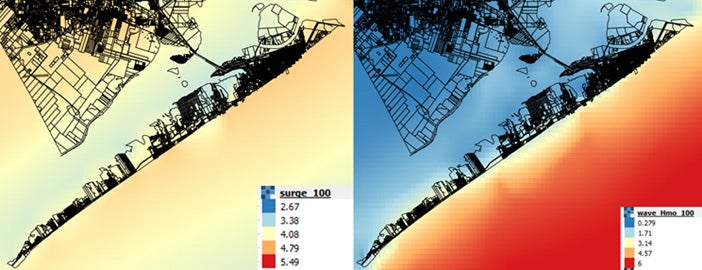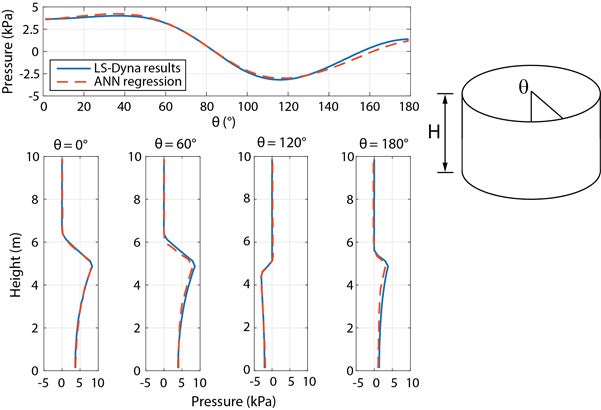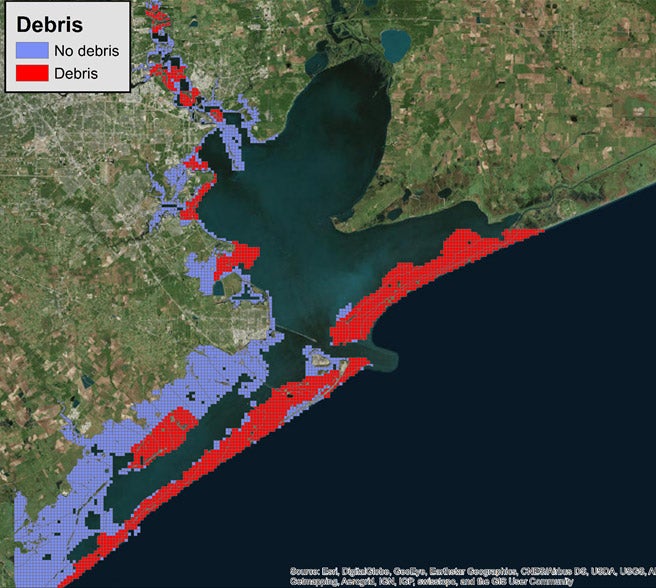Machine Learning for Structural Reliability and Risk Assessment Applications
Analyzing the loads and response of complex structures such as bridges and coastal structures subjected to natural hazards such as earthquakes, hurricane surge and wave requires performing high fidelity nonlinear finite element analysis with significant computational cost. In addition, building fragility curves for bridges and other infrastructure systems requires a large number of training samples to accurately capture the low probabilities of failure. As a result, work in the Padgett Research Group introduces surrogate models for predicting the structural response and consequently the fragilities for these structures, leveraging machine learning techniques used for classification and regression problems. Other applications employ machine learning techniques for probabilistic hazard modeling, such as surrogate models of hurricane surge and wave derived to alleviate the computational cost of high fidelity hydrodynamic models. Ultimately our work employs a combination of physics-based and data driven methods for improving the accuracy and efficiency of reliability and risk assessments.
A) Probabilistic hurricane hazard metamodeling
Description: Risk assessments of coastal structures requires knowledge of storm surge and wave conditions at the structure locations for various hurricane scenarios. Such information can be obtained via high-fidelity coastal hydrodynamic numerical models such as ADCIRC+SWAN; however, such numerical models are very computationally demanding. Therefore, Padgett Research Group is actively developing surrogate models to predict storm hazard conditions and alleviate these computational constraints. The surrogate models are trained on a small set of numerical simulations of hurricanes along the Texas and Louisiana coasts. They can then predict surge elevation, wave height, wave period, and inundation periods at any desired location to support probabilistic risk assessments of coastal structures during hurricane events. More importantly, these models can provide accurate hazard predictions in matter of minutes compared to thousands of CPU-hours for the numerical models. Such models pave the way for probabilistic risk assessment of infrastructure in coastal hazard-prone locations.
Figures:

B) Surrogate modeling of loads acting on coastal structures
Description: Developing fragility models requires good estimates of the loads acting on structures. While some load models are readily available in the literature or may be estimated through analytical approaches, finite element modeling is often required to determine loads, forces, or pressures on structures. Such finite element models can be computational expensive, especially if complex phenomena such as fluid-structure interaction or wave breaking need to be modeled. Therefore, Padgett Research Group is developing surrogate models to predict loads on coastal structures. These surrogate models are based on a small set of finite element simulations and using statistical sampling methods to adequately cover the space of load parameters. Surrogate models, based on Artificial Neural Networks or Multivariate adaptive regression splines, were developed to estimate hydrodynamic pressure distributions around aboveground storage tanks subjected to storm surge and wave loads (see figure below) as well as impact forces on coastal bridge decks subjected to wave loads. These models can then provide accurate and computationally inexpensive load estimates to develop fragility models across ranges of hazard parameters.
Figures:

C) Structural response and fragility development using surrogate models
Description: A significant body of work in the Padgett Research Group leverages surrogate models, or metamodeling, in the prediction of structural response of fragility of systems exposed to multiple hazards. For example, in order to increase the size of the training set for predicting bridge failures, a dual layer metamodeling approach is used. Surrogate models or metamodels trained from a set of bridge simulations is used to predict bridge component responses, like column displacement or curvature. Models commonly employed for these include polynomial response surface models, regression trees, neural networks, elastic nets as well as support vector machines. The best model is then used to generate more response data that forms the input of the second metamodel which predicts failure based on the response limits. Logistic regression (among other candidate) models are used to compute bridge failure probabilities in the form of a parameterized fragility. These parameterized fragilities can be applied to a portfolio of bridges in a region and rapidly assess the vulnerability of bridges for regional risk assessment. They also offer the opportunity to explore parameter variations or sensitivity and inform design processes.
Figure:

D) Data-driven modeling of surge-induced debris in urban regions
Description: Padgett Research Group is also using machine learning techniques to develop data-driven models for large-scale effects during storm or hurricane events. Currently, these models mainly focus on debris quantities generated during storm events and the potential location of such debris in large-scale urban areas in order to support government agencies with adequate information and facilitate recovery efforts. Such probabilistic debris models have direct impacts on adequately assessing transportation access in a region, particularly during the emergency response phase, as well as long term recovery and debris management.
Figure:

